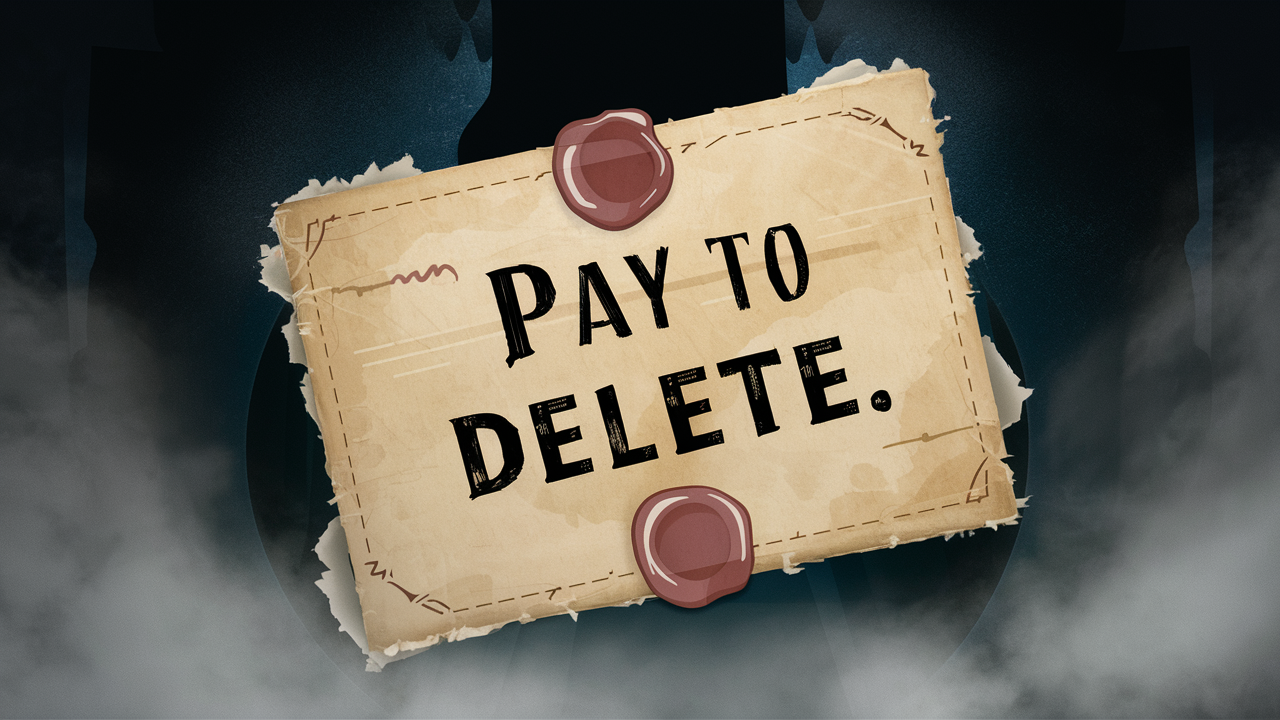-
Posted on: 24 Jul 2024

-
Your credit score is a crucial aspect of your financial life. It influences your ability to secure loans, rent an apartment, and even get a job. Negative items on your credit report can significantly impact your score. One strategy some people explore to address these issues is using a "pay-to-delete" letter. But what exactly is a pay-to-delete letter, and is it a legitimate way to improve your credit?
Understanding Pay-to-Delete Letters
A pay-to-delete letter is a written agreement you attempt to make with a creditor or collection agency. The core idea is simple: you offer to pay off a debt in exchange for the creditor agreeing to remove the negative information associated with that debt from your credit report. The goal is to eliminate the derogatory mark, thereby boosting your credit score.
The premise is that the creditor benefits by receiving payment for a debt that may have been difficult to collect, and you benefit by having the negative entry removed from your credit report. It's essentially a negotiation tactic to improve your creditworthiness.
How Pay-to-Delete Letters Work
The process typically involves the following steps:
- Identify the Negative Item: Review your credit reports from all three major credit bureaus (Equifax, Experian, and TransUnion) to identify the specific negative account you want to address.
- Research the Creditor or Collection Agency: Determine who currently owns the debt. It might be the original creditor or a collection agency that purchased the debt.
- Draft the Pay-to-Delete Letter: This is the most crucial step. The letter should clearly state your offer: you will pay a specific amount (ideally a negotiated amount, not the full balance) in exchange for the creditor removing the negative item from your credit report.
- Send the Letter (Certified Mail): Send the letter via certified mail with return receipt requested. This provides proof that the creditor received your offer.
- Negotiate (if necessary): The creditor might counter your offer or reject it outright. Be prepared to negotiate the payment amount or the terms of the agreement.
- Get the Agreement in Writing: If the creditor agrees to your terms, ensure you receive a written agreement confirming their commitment to remove the negative item from your credit report once payment is received. This is critical.
- Make the Payment: Once you have the written agreement, make the payment as agreed upon. Keep records of your payment (e.g., canceled check, money order receipt).
- Monitor Your Credit Report: After making the payment, regularly monitor your credit reports from all three bureaus to ensure the negative item is indeed removed as agreed. This can take 30-60 days.
What to Include in a Pay-to-Delete Letter
A well-crafted pay-to-delete letter is essential. Here's a breakdown of the key elements to include:
- Your Contact Information: Full name, address, phone number, and email address.
- Account Information: The specific account number and the name of the creditor or collection agency.
- Clear and Concise Offer: Clearly state that you are offering to pay a specific amount in exchange for the removal of the negative item from your credit report. For example: "I am offering to pay [Dollar Amount] in exchange for your agreement to remove the account number [Account Number] from my credit reports with Equifax, Experian, and TransUnion."
- Confirmation of Deletion: Specify that you require written confirmation of the deletion once payment is received.
- Payment Method: State how you plan to make the payment (e.g., certified check, money order).
- Deadline: Set a reasonable deadline for the creditor to respond to your offer.
- Date and Signature: Date and sign the letter.
Example Snippet:
[Your Name] [Your Address] [Your Phone Number] [Your Email Address] [Date] [Creditor/Collection Agency Name] [Creditor/Collection Agency Address] RE: Account Number: [Account Number] Dear [Creditor/Collection Agency Contact Person], I am writing to you regarding account number [Account Number], which appears on my credit report as a past-due debt. I am willing to resolve this debt with a payment of $[Agreed Upon Amount] in exchange for your written agreement to completely remove this account from my credit reports with Equifax, Experian, and TransUnion. Upon receipt of my payment, I require written confirmation that you have deleted the account from my credit reports with all three major credit bureaus...
Legality and Effectiveness of Pay-to-Delete
The legality of pay-to-delete agreements is somewhat nuanced. While it's not inherently illegal for a creditor to remove information from your credit report in exchange for payment, many creditors are hesitant to do so. Here's why:
- Reporting Accuracy: Credit bureaus prefer accurate reporting of credit information. Deleting a legitimate debt, even if paid, can be seen as inaccurate reporting.
- Internal Policies: Many creditors have internal policies that prohibit them from deleting information from credit reports, regardless of whether the debt is paid.
- Fair Credit Reporting Act (FCRA): The FCRA requires credit reporting agencies and creditors to report accurate information. Deleting a valid debt could be seen as a violation of this act.
Effectiveness: While a pay-to-delete letter *can* work, it's not a guaranteed solution. Many creditors will simply refuse the offer. It's more likely to be successful with smaller collection agencies than with large, established creditors. Even if a creditor initially agrees, they might not follow through, so getting a *written* and legally sound agreement is paramount.
Risks Associated with Pay-to-Delete Letters
Before pursuing a pay-to-delete strategy, consider these potential risks:
- No Guarantee: The creditor may not agree to your offer, leaving you with no improvement to your credit report.
- Payment Without Deletion: Even with a written agreement, the creditor might fail to remove the negative item after you've made the payment. This is why a solid, legally binding agreement is crucial.
- Revival of Statute of Limitations: In some jurisdictions, making a payment on a debt that is near the statute of limitations can restart the clock, giving the creditor more time to sue you to collect the full debt. Be aware of the statute of limitations on debt in your state.
- Difficulty Enforcing the Agreement: Even with a written agreement, enforcing it legally can be challenging and costly. You may need to hire an attorney to pursue legal action if the creditor doesn't honor their agreement.
- Debt Validation Required: Before making any payments, especially to a collection agency, ensure the debt is valid. Request debt validation to confirm that the collection agency has the legal right to collect the debt and that the information they have is accurate.
Alternatives to Pay-to-Delete
If a pay-to-delete letter seems too risky or unlikely to succeed, consider these alternative strategies for improving your credit:
- Debt Validation: As mentioned earlier, request debt validation from the collection agency. If they cannot provide proof that they own the debt or that the information is accurate, they are legally obligated to stop collection efforts and remove the item from your credit report.
- Credit Dispute: If you believe the information on your credit report is inaccurate or incomplete, file a dispute with the credit bureaus. They are required to investigate your claim within 30 days.
- Debt Settlement: Negotiate a settlement with the creditor or collection agency to pay a portion of the debt in exchange for a "settled" or "partially paid" notation on your credit report. While this still impacts your credit, it's often less damaging than a "charge-off" or "collection" status.
- Time: Negative items eventually fall off your credit report. Most negative information remains on your credit report for seven years. Bankruptcies can stay on for up to 10 years.
- Good Credit Habits: The most effective long-term strategy is to establish and maintain good credit habits. Pay your bills on time, keep your credit card balances low, and avoid opening too many new accounts at once.
The Psychology of Negotiation
Successfully negotiating a pay-to-delete agreement, or any debt-related agreement, requires understanding the creditor's perspective. They are trying to maximize their recovery on the debt. Your goal is to minimize the negative impact on your credit while resolving the debt. Consider these negotiating tips:
- Be Polite and Professional: Maintain a respectful tone in all communications.
- Do Your Research: Understand the fair market value of the debt and the creditor's typical recovery rate.
- Offer a Reasonable Amount: Don't offer an amount that is unrealistically low. Start with a reasonable offer and be prepared to negotiate.
- Highlight Your Situation: Explain your circumstances, such as any financial hardships you're facing.
- Be Prepared to Walk Away: Know your limits and be prepared to walk away if the creditor is unwilling to negotiate reasonable terms.
Monitoring Your Credit Reports
Regardless of which strategy you choose, monitoring your credit reports regularly is essential. You can obtain free credit reports from each of the three major credit bureaus annually at AnnualCreditReport.com. You can also use credit monitoring services offered by various companies, some of which are free. Look for services that provide alerts when changes occur on your credit report. Monitoring allows you to identify and address any inaccuracies or discrepancies promptly.




